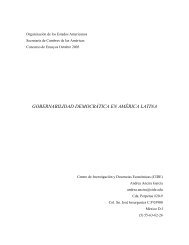The Road to Hemispheric Cooperation: Beyond the Cartagena
The Road to Hemispheric Cooperation: Beyond the Cartagena
The Road to Hemispheric Cooperation: Beyond the Cartagena
You also want an ePaper? Increase the reach of your titles
YUMPU automatically turns print PDFs into web optimized ePapers that Google loves.
as many scientists believe, this paltry sum will do little <strong>to</strong><br />
stave off impending global catastrophe. Although <strong>the</strong> U.S.<br />
economic recovery remains tenuous and its fiscal situation<br />
is precarious, <strong>the</strong> monies appropriated <strong>to</strong> ECPA <strong>to</strong> date by<br />
<strong>the</strong> U.S. government are embarrassingly meager. By way<br />
of comparison, <strong>the</strong> United States in recent years has spent<br />
approximately $4.4 trillion dollars on two wars in Afghanistan<br />
and Iraq. 28 If <strong>the</strong> richest country in <strong>the</strong> Americas has<br />
failed <strong>to</strong> make any serious investment <strong>to</strong> fund initiatives<br />
under ECPA, it is highly unrealistic <strong>to</strong> expect o<strong>the</strong>r governments<br />
<strong>to</strong> make up <strong>the</strong> difference. It speaks volumes that<br />
nei<strong>the</strong>r President Obama, in his speech <strong>to</strong> <strong>the</strong> heads of<br />
state ga<strong>the</strong>red at <strong>the</strong> Sixth Summit of <strong>the</strong> Americas, nor a<br />
senior member of <strong>the</strong> U.S. delegation, raised ECPA.<br />
Meager Results from <strong>the</strong> Sixth Summit of <strong>the</strong> Americas<br />
on Energy and Climate Change<br />
<strong>The</strong> Sixth Summit of <strong>the</strong> Americas meeting in <strong>Cartagena</strong><br />
in April 2012 focused on interconnecting <strong>the</strong> physical infrastructure<br />
of <strong>the</strong> Western Hemisphere at <strong>the</strong> national,<br />
regional, and sub-regional levels. In his opening address,<br />
Colombian President Juan Manuel San<strong>to</strong>s set forth <strong>the</strong><br />
goal in this way:<br />
“working, with <strong>the</strong> support of multilateral institutions,<br />
<strong>to</strong> develop programs and projects for physical infrastructure<br />
and electrical interconnection <strong>to</strong> integrate <strong>the</strong><br />
Americas” and “establishing appropriate coordination<br />
<strong>to</strong> prevent and respond <strong>to</strong> natural disasters…, including<br />
those caused by climate change.” 29<br />
One of <strong>the</strong> specific mandates coming out of <strong>the</strong> <strong>Cartagena</strong><br />
Summit was <strong>to</strong> “promote and/or optimize electrical interconnection<br />
and foster <strong>the</strong> development of renewable energy<br />
generation in <strong>the</strong> Americas.” 30 Given <strong>the</strong> disappointing results<br />
produced by previous efforts in Latin America <strong>to</strong> connect<br />
national electricity grids across borders, it is perplexing<br />
that this <strong>to</strong>pic received such prominence in <strong>Cartagena</strong>, o<strong>the</strong>r<br />
than <strong>the</strong> fact that, if it came <strong>to</strong> pass, it would be economically<br />
beneficial for Colombia. Not only will <strong>the</strong> type of interconnection<br />
that is proposed from Panama <strong>to</strong> Chile require<br />
a herculean effort <strong>to</strong> complete and absorb huge amounts of<br />
capital, it will also require major changes <strong>to</strong> domestic laws<br />
in order <strong>to</strong> ensure some level of harmonization that can facilitate<br />
cross-border sales of electricity. 31 Fur<strong>the</strong>rmore, it is<br />
unclear from where <strong>the</strong> electricity will be generated. It is<br />
presumed <strong>to</strong> come from Colombian hydroelectric dams, but<br />
<strong>the</strong> future viability of this resource is threatened by climateinduced<br />
melting of Andean glaciers. More realistic is <strong>the</strong><br />
mandate “<strong>to</strong> encourage <strong>the</strong> transfer of available technologies<br />
in energy under voluntary and mutually agreed terms,<br />
as well as <strong>the</strong> exchange of best practices.”<br />
Surprisingly, given its inclusion as a mandate from previous<br />
Summits of <strong>the</strong> Americas, <strong>the</strong> <strong>Cartagena</strong> Summit was<br />
silent on <strong>the</strong> issue of conservation and energy efficiency.<br />
Energy efficiency is <strong>the</strong> cheapest and easiest way <strong>to</strong> reduce<br />
greenhouse gas emissions. Efficiency and conservation<br />
will lead <strong>to</strong> more significant reductions in greenhouse<br />
gas emissions over a shorter period of time than <strong>the</strong> gains<br />
from enhanced reliance on renewable energy alternatives,<br />
such a solar and wind power combined, due <strong>to</strong> current technological<br />
constraints. <strong>The</strong> International Energy Agency estimates<br />
that greater efficiency could reduce current green<br />
house gas emissions by two-thirds, while <strong>the</strong> McKinsey<br />
Global Institute thinks energy efficiency could get <strong>the</strong> world<br />
halfway <strong>to</strong>ward <strong>the</strong> goal, espoused by many scientists, of<br />
keeping <strong>the</strong> concentration of greenhouse gases in <strong>the</strong> atmosphere<br />
below 550 parts per million. 32 <strong>The</strong> only reference<br />
<strong>to</strong> climate change arising from <strong>the</strong> <strong>Cartagena</strong> Summit is a<br />
<strong>to</strong>othless, boilerplate mandate under <strong>the</strong> heading of “Disaster<br />
Reduction and Management” that calls on <strong>the</strong> governments<br />
of <strong>the</strong> Western Hemisphere <strong>to</strong> “work with regional,<br />
sub-regional, and international financial institutions with <strong>the</strong><br />
aim <strong>to</strong> streng<strong>the</strong>n financing mechanisms for adaptation <strong>to</strong><br />
climate change.” 33<br />
Recommendations<br />
<strong>The</strong> Sixth Summit of <strong>the</strong> Americas in <strong>Cartagena</strong> was most<br />
notable for <strong>the</strong> failure of <strong>the</strong> United States <strong>to</strong> exert any<br />
leadership role on <strong>the</strong> crucial issues of energy security and<br />
climate change. In his official address, President Obama<br />
made only passing reference <strong>to</strong> forging clean energy and<br />
climate partnerships in <strong>the</strong> Western Hemisphere, and never<br />
mentioned <strong>the</strong> ECPA. This was a remarkable omission<br />
as <strong>the</strong> ECPA has been <strong>the</strong> U.S. government’s official submission<br />
for fulfilling <strong>the</strong> energy and climate change related<br />
mandates arising from <strong>the</strong> Trinidad Summit in 2009. 34<br />
By downplaying energy and climate change, Washing<strong>to</strong>n<br />
risks ceding <strong>the</strong> initiative—at least in South America—<strong>to</strong><br />
<strong>The</strong> <strong>Road</strong> <strong>to</strong> <strong>Hemispheric</strong> <strong>Cooperation</strong>: <strong>Beyond</strong> <strong>the</strong> <strong>Cartagena</strong> Summit of <strong>the</strong> Americas<br />
<strong>The</strong> Brookings Institution ❘ Latin America Initiative<br />
53








